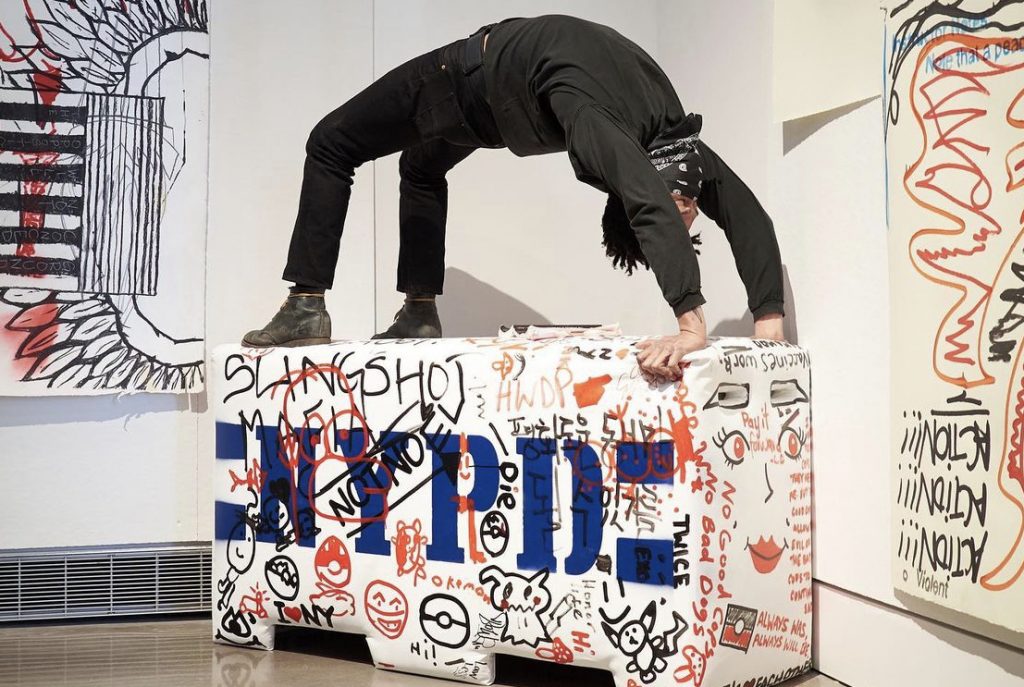YoU Dispatch Questionnaire: Julian Louis Phillips
September 1, 2022
At the conclusion of YoU, the Artists-In-Residence were asked seven questions about their experience and the overall mission of this collaborative program. Five artists shared their responses, which can be viewed in their entirety below. A large-format broadsheet was also produced to highlight a selection of answers and images that delve into the strengths and challenges of interconnectedness, and the continued work to be done within the institution.

Image description: Artist Julian Louis Phillips is doing a bridge pose on one of his Barricade pieces, a sculpture with blue N Y P D text and red and black collaborative graffiti. He is wearing a black bandana that is covering his mouth, a black long-sleeve shirt, black jeans, and black boots.
Question 1: Was there a relationship you built during YoU that impacted your work in a meaningful way?
One of the most beautiful relationships that formed during YoU was my relationship with the Museum Experience Ambassadors. My Barricades sculptures simulate the appearance of NYPD concrete barricades and critically examine the relationship between policing and public space.I knew that the folks that would have the most intimate relationship with the piece would be the Ambassadors. We had a special workshop talking about how to interact with the piece and assist visitors to the Museum so they’d get the most out of interacting with the objects. The Ambassadors would share interactions the public had with the work and how they saw it developing. This was particular to Barricades because of the nature of the sculpture. Still, this relationship was bountiful in talking about all of my work in the exhibition and the exhibition as a whole.
Question 2: Which theme was most relevant to your work throughout YoU?
I think the most obvious theme is Justice when you look at the subject matter of my work. But truly believe Care is at the center of the work of abolition and decolonization. I continue to reflect on Care because of all of the thought and meaningful conversations that went into trying to develop situations and artwork that allowed folks to wrestle with hard subjects around policing and the effects of a carceral state. We cannot attend abolitionist futures without a commitment to caring for each other, our experiences, and ourselves.
Question 3: How has your work embraced uncertainty?
I do not make without a degree of uncertainty. There is a facet of the unknown that I embrace in my practice. However, this exhibition stretched that muscle in the fact as I was making the exhibition was being formed. Nothing was static and allowed experimentation and improvisation at every turn. As I turned very public and personal events of 2020 into work that dug deeper beyond headlines, I learned how we as a culture want to consume ideas that challenge the basis of our societies.
Question 4: What are two things you learned from YoU?
I have learned always take my time and never be afraid to ask questions until I can formulate a sufficient answer. I have also learned that there is nothing that does not belong in a museum.

Image Description: A group of masked teenagers are observing a wall covered in letter-size protest posters at the Queens Museum. Artist Julian Louis Phillips is seen from the back wearing a black shirt and green shorts. His right hand is pointing to his right ear, and his left hand is pointing to one of the posters on the wall.
Question 5: What does a “community museum” mean to you?
“Community Museum” means a museum that decenters itself from what it means canonically to be a museum and centers itself around the voices, concerns, and needs of a community. It means to fundamentally redefine what a museum means. What does a museum hold? What does it exhibit? How do those things shape and form the reciprocal relationship a museum has with a community?
Question 6: Did YoU change the way you exist within museums?
Until YoU there were not many museums that existed in, though I am well acquainted with that art industry. Museums are perfect examples of the distribution of resources, and participation in YoU helped me understand how I use the resources around me and that are intrinsic to who I am. These resources are not infinite and readily have to be replenished – especially those resources that are cultural labor.
Question 7: What do you think is the most important question or issue about the role of museums that arose during YoU?
I believe that museums need to fundamentally understand their relationship to and within capitalism. We have seen that this economic system is inherently unsustainable and simply asking questions about the ills of this economic system rather than radically changing it will only prolong ecological degradation and cultural divisions. As an institution that promotes and upholds the ideals of our species, a forward-thinking museum must actively counteract the system of capitalism and empower others to do the same. This may mean that the museum will look very different from how we have come to know it, but these actions are paramount. Without taking a stand with the poor and working people who build and make culture, all museums will be irrelevant.
Related Tags